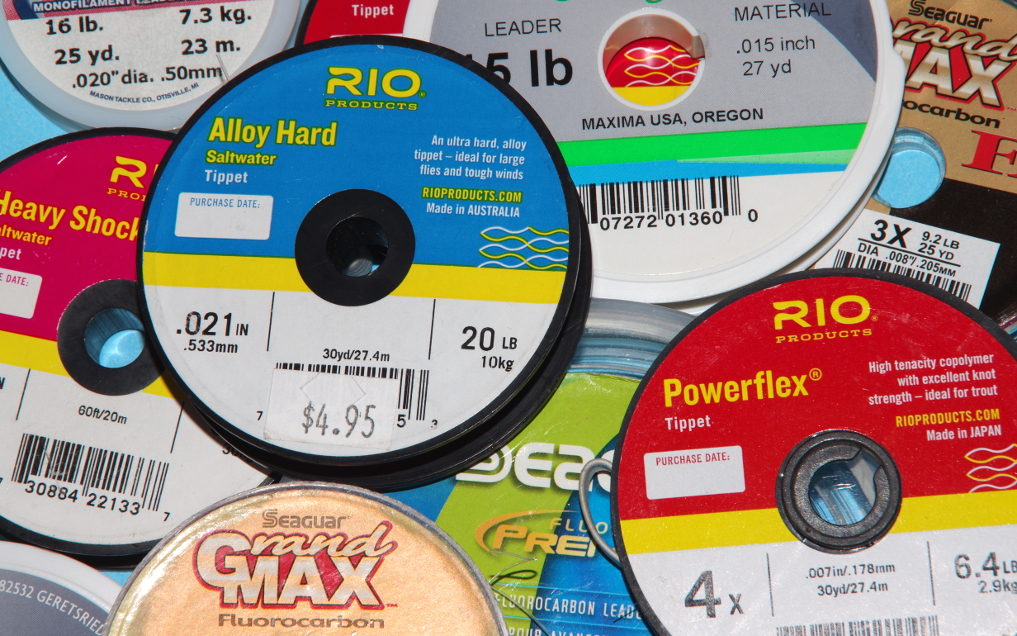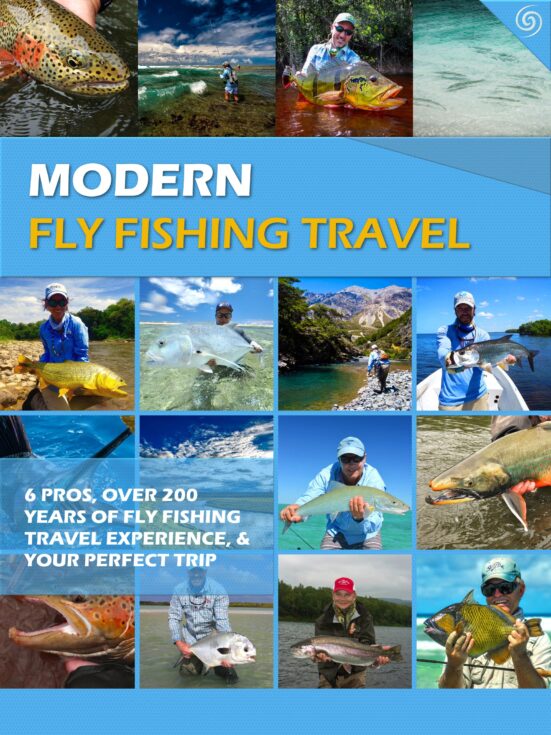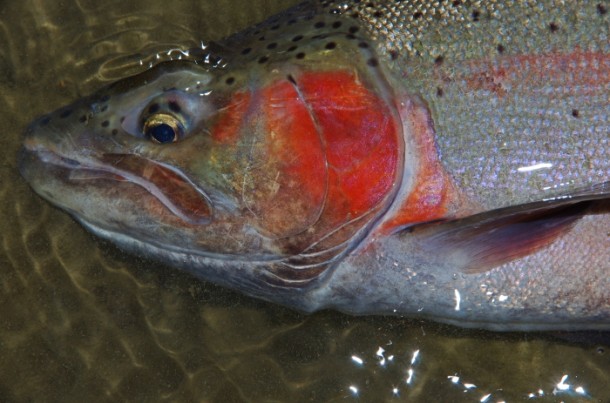There are hundreds, if not thousands, of options to choose from with our fly fishing leaders and tippets. No matter which tippet or leader you choose, it will affect your fly fishing dramatically. Each leader or tippet offers you ways to really improve your fly fishing through the specific qualities they offer.
At the end of this article, you shouldn’t feel confused when looking at the hundreds of different types of tippets and leaders you see online or in fly shops, and you’ll be able to catch a lot more fish because you’ll be able to fool and land these fish much more effectively.
FOR A SUMMARY OF FLY FISHING LEADERS AND TIPPETS, CLICK HERE
BASICS OF FLY FISHING LEADERS AND TIPPETS
BASIC SETUP
Before we discuss all aspects of fly fishing leaders and tippets, we need to make sure that you understand the basics of leaders and tippets. With every fly fishing setup, you will have possibly 5 different sections, connected with the right fly fishing knots, until you get to the fly: backing, fly line, butt section, leader, and tippet.
WHAT IS A FLY FISHING LEADER?
A complete fly fishing leader is usually the last 3 parts of the 5-part fly fishing setup, connecting to the fly line: the butt section, leader (or midsection), and tippet. Much of the time leaders taper down from large to small diameter line. These are referred to as a “tapered leader.” This allows the fly to land softly while also giving the angler some power in the cast, since the larger the diameter, the more power you have, and the smaller the diameter, the softer the line lands on the water. This is always a balance in fly fishing: what is best for casting, and what is best for presenting the fly to the fish.
WHAT IS FLY FISHING TIPPET?
Fly fishing tippet is the last part of your leader that connects to the fly. Sometimes the tippet is treated as a separate piece of the leader, but really, it’s just one part of the leader. We can think of the butt section as the end that connects to the fly line, and we can think of the tippet as the end that connects to the fly.
Fly anglers will buy extra tippet to connect to their leaders so they do not eat into the taper. Every time you cut a bit from your tapered leader, to replace a fly for example, you lose taper. As you add tippet initially or as your leader gets shorter and shorter, you preserve the taper of your fly fishing leader.
Fly anglers also use tippet to connect multiple flies to their fly fishing rigs, and they will also extend the taper of their leader in certain finesse fly fishing scenarios.
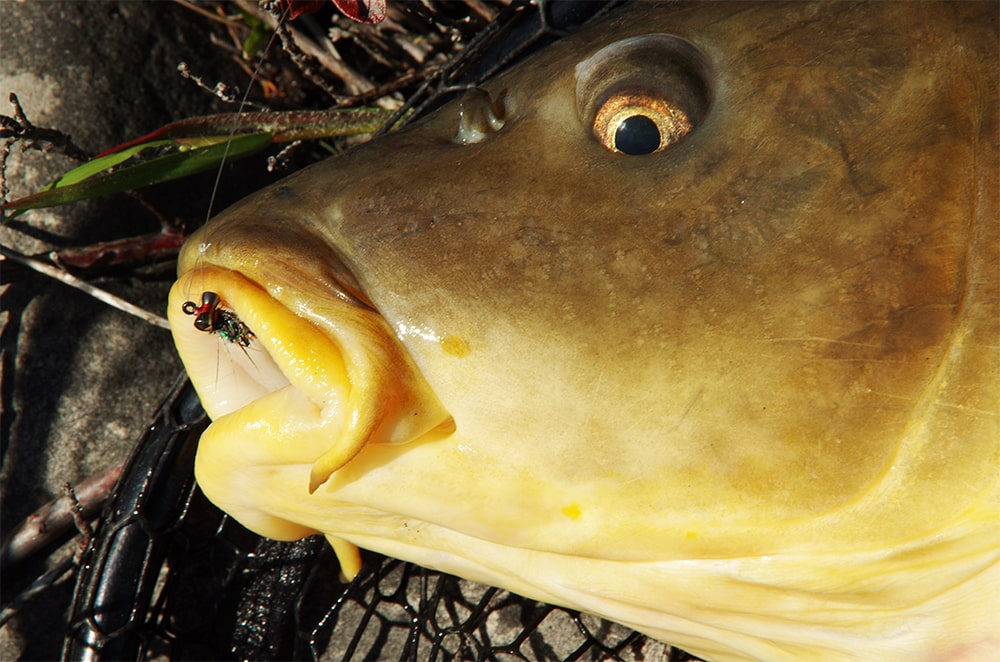
TWO BASIC OPTIONS FOR FLY FISHING LEADERS
BUILD A FLY FISHING LEADER
There are two options for your leader, build your own or buy the leader premade. If you create your own, there are literally endless combinations and designs of these leaders. You can go as basic as using one piece of monofilament with one diameter tied to the fly line and the fly. In this case, the butt section and tippet are the exact same diameter, and there are no knots.
You could also create a leader that has 10 different sections tapering down from large to small, attached with fly fishing knots. You can use any material you want in your leader design as well, so you could incorporate fishing line made by any fishing manufacturer in the world, as long as it gives you the qualities you want for your leader.
This gives you choices for different sections of your leader. For example, you could go stiff and heavy on the butt section and supple and light on the tippet section. Leader design is much too large of a topic for this article, but understand you have man different options.
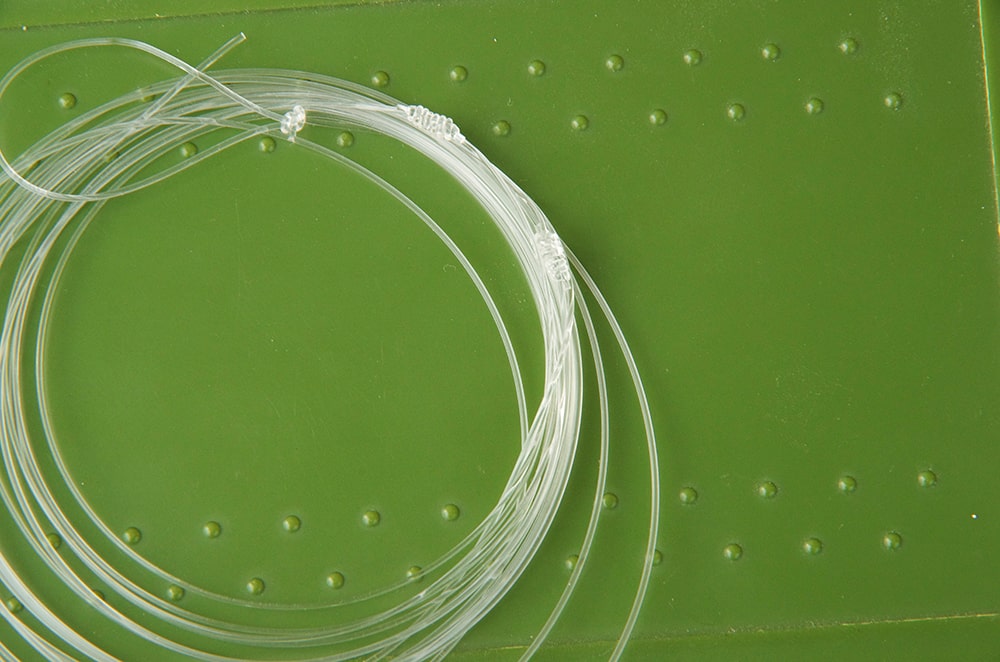
BUY A FLY FISHING LEADER
Another option, and easier in general, is to buy a premade fly fishing leader. This is as easy as making any purchase you’ve ever made. Many manufacturers have hundreds of premade leaders for saltwater and freshwater. Most of these leaders will not have knots except on the butt section to connect it to the fly line. This allows your leader to slide through the water easily and not gather any debris or vegetation on your leader’s knots. Some premade leaders have been tied by hand, however. These will almost always be a bit more expensive.
You can choose to buy a premade leader and use it as is, or you can add a butt section and a bit of tippet to either end to preserve the taper, since the more you use it, the more you will eat into the taper.
Both options give you choices, but the key to making these choices is to understand the qualities of the materials used and the decisions you’ll make when building or buying your leaders and tippets.
See examples of tippet and premade leaders here.
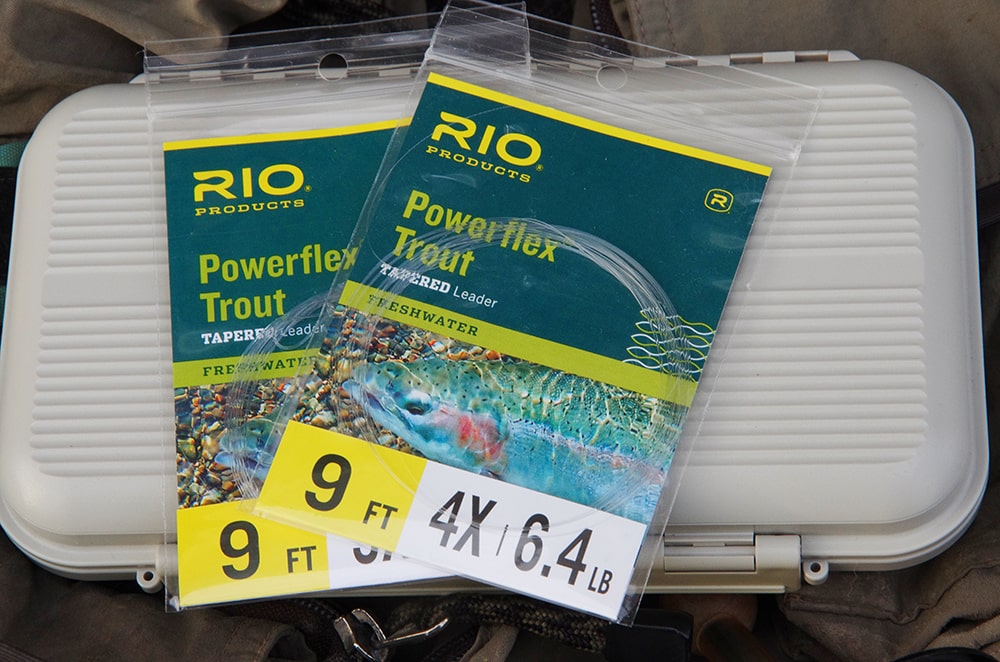
DIFFERENT MATERIALS OF FLY FISHING LEADERS AND TIPPETS
There are 2 main different materials that tippets and leaders come in: nylon and fluorocarbon. Both are monofilaments, although nylon is referred to as “monofilament” most of the time. Monofilament means that they are one filament extruded out, not a bunch of filaments twisted together like braided fishing lines, which are mainly used in conventional tackle fishing. Both nylon and fluoro have specific qualities that aid in casting, presentation, and landing fish, which we will explore below.
There is also another type of material that anglers use as well, but they use this with toothy fish like sharks, barracuda, pike, musky, and bluefish. These are the different types of wire leader/tippet materials that are available to both conventional and fly anglers alike.
FLY FISHING LEADER AND TIPPET QUALITIES AND HOW THEY AFFECT YOUR FISHING
Each type of fluorocarbon, nylon, or metal wire we choose has unique qualities that will make or break our fishing success in many instances.
There are well over a dozen factors to consider when buying fly fishing tippet or leaders. We can divide our fly fishing leader and tippet uses into two main parts: “the grab” (presenting the fly and fooling the fish into striking) and “the nab” (bringing the fish to hand after it strikes the fly). Let’s explore these two purposes below.
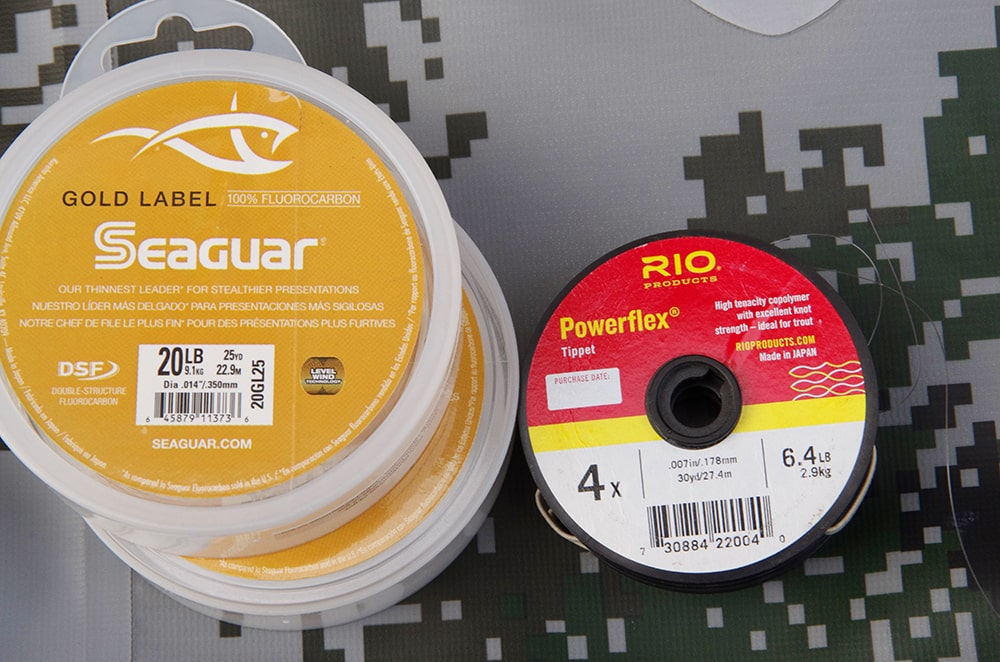
A NOTE ON FLY FISHING LEADERS AND TIPPETS
There are certain features of your leaders and tippets that are important, but are more general or connected to your leader design. Two aspects of leaders and tippets are leader length and leader/tippet durability.
Leader length is connected to your design, which is a whole different topic. Just know that having a long/short leader will affect casting (short = more power; long = less) and presentation. Length affects presentation in many different ways from sink rate to drag put on your line.
Durability is another aspect to consider. Fluorocarbon, for example, is more longer-lasting than most nylon monofilaments. For the most part, durability (not abrasion resistance) is a cherry on top when it comes to other aspects of leaders and tippets.
THE “GRAB” WITH FLY FISHING LEADERS AND TIPPETS
The first consideration when trying to catch a fish is triggering the fish to “grab” the fly. There are at least 5 main leader and tippet characteristics that play a major role in your presentation to a fish: suppleness/stiffness, diameter, sink rate, color, and visibility. We need to consider 2 aspects of presentation along with these 5 factors: 1) presenting the fly in or on the water 2) fly casting.
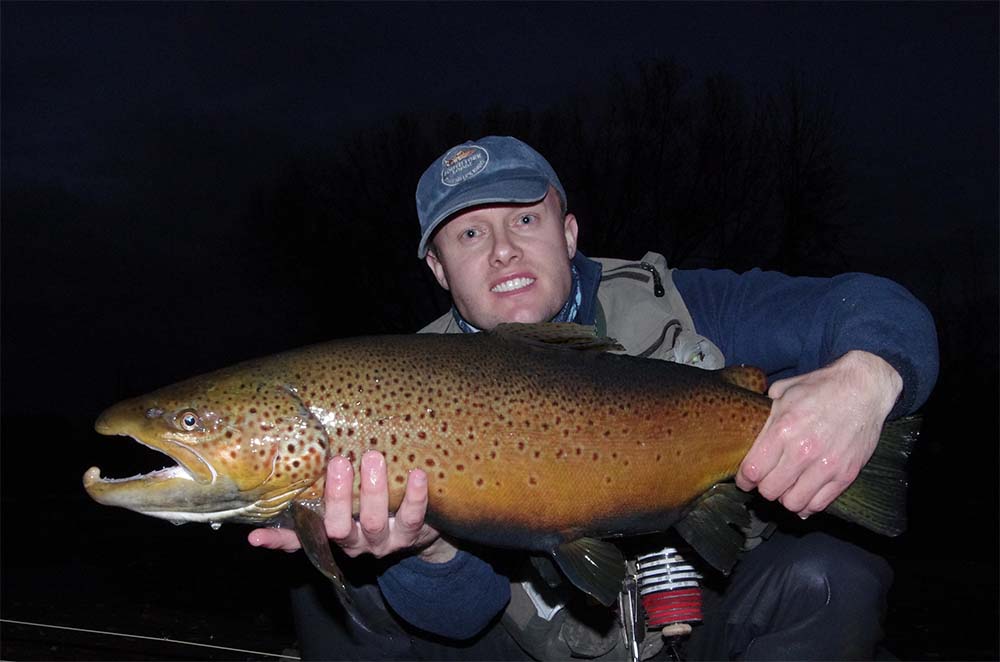
THE “GRAB”: HOW LEADERS AND TIPPETS AFFECT CASTING
DIAMETER
Two of the factors (suppleness/stiffness and diameter) affect presentation through your casting. First, the diameter is hugely important. Diameter has been so important for fly fishing historically that the use of the “X” system has been the symbol used to buy tippet and designated the final tippet size on tapered leaders for hundreds of years.
UNDERSTANDING THE X SYSTEM OF FLY FISHING TIPPETS
Fly fishing tippet was made from a translucent membrane within the gut of the silkworm, which is about 12 – 18 inches long and is still sold today. The diameter of this membrane was measured in inches in England after the worm’s importation into England from China.
Thus was born the “rule of 11” which means that the tippet size “X” value (3x, 5x, etc.) plus the diameter (in thousands of an inch) must equal 11. In this way, you can determine what the diameter is by subtracting the X-factor from 11. This is why higher X numbers are actually smaller in diameter.
Example: 2x tippet has a diameter of .009, 11 – 2 = 9 (.009). This holds true up to 0x.
| X VALUE | DIAMETER | ESTIMATED BREAKING STRENGTH |
|---|---|---|
| 8x | .003 (.076 mm) | 1.5lb (0.7 kg) |
| 7x | .004 (.102 mm) | 2 lb (0.9 kg) |
| 6x | .005 (.127 mm) | 3 lb (1.4 kg) |
| 5x | .006 (.152 mm) | 4 lb (1.8 kg) |
| 4x | .007 (.178 mm) | 6 lb (2.7 kg) |
| 3x | .008 (.203 mm) | 8 lb (3.6 kg) |
| 2x | .009 (.229 mm) | 10 lb (4.5 kg) |
| 1x | .010 (.254 mm) | 12 lb (5.4 kg) |
| 0x | .011 (.279 mm) | 14 lb (6.4 kg) |
THE IMPORTANCE OF FLY FISHING LEADER AND TIPPET DIAMETER
Because the diameter of your line determines partly the power you can generate during a cast. The diameter of your tapered leader and/or your tippet size determine energy dissipation, that is, how much energy is lost on the cast. Practically speaking, the larger the diameter, the more power you will have when casting. The power in your fly casting is lost when small diameters are attached to the fly line. Also, a larger diameter tippet/leader will have more weight and thus inertia once it gets moving.
The length of your fly fishing leader affects power as well, but this factor is tied up (no pun intended) with leader formulas, which are another article/book entirely. Just know that a shorter leader will have more power, all other factors being equal. For example, in windy conditions, you want a shorter leader for casting purposes.
When we have consistently similar diameters in our leaders, the tapered leader has even energy transfer, and our leaders will lay out with maximum force while still landing softly enough to avoid spooking fish. So, 5 feet of .009 tippet will be infinitely more powerful than 5 feet of .004 diameter tippet. One is better for casting streamers on trout lakes, and the other is better for tiny flies on spring creeks. You can use 1,000 lb. test to try and get more power in your cast, but if your 20 lb. test has a larger diameter (all other factors being equal), the 20-pound test will still cast farther with the same amount of effort. Note it is the diameter, NOT THE BREAKING STRENGTH, that aids the cast.
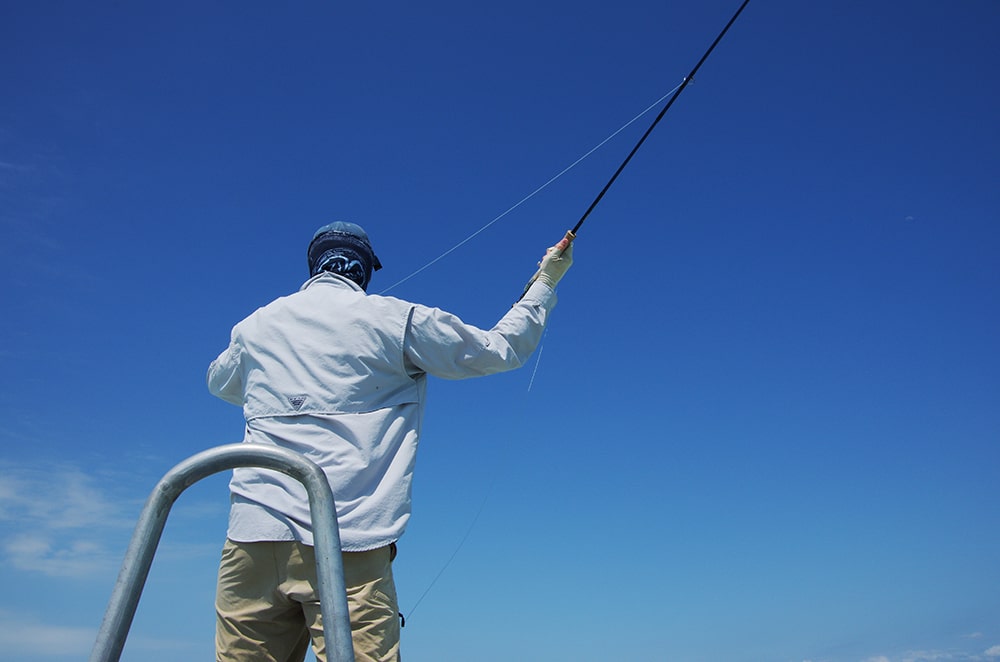
SUPPLENESS/STIFFNESS
The other factor that affects casting is the suppleness/stiffness of your nylon, fluoro, or braid. A simple rule is, all other factors being equal, the stiffer the line, the easier it will shoot and turn over a fly, unless cold temperatures are so bad that your line will not straighten out.
Think about a limp spaghetti noodle vs. a piece of monofilament of the same thickness and length. If you tie a nymph on the noodle, bend it back, and let it go, nothing will happen. However, the stiff piece of mono will use its potential energy and spring forward under the same bend. Incidentally, fly line cores are often made from monofilaments, so that fly lines with stiff mono cores shoot much better than lines with limp cores (heat or cold affects this as well).
So, as we design our leaders or choose tippets and other monofilaments, we need to think about the conditions we are fishing in. Do we need maximum power with little concern over our flies smashing the water, for example, while fishing to trout in lakes in an impossible wind, or do we need high dissipation of energy so that our leader lands lightly on the water in front of a big spring creek brown? The stiffness/suppleness and diameter of our leaders will help us cast appropriately to the conditions.
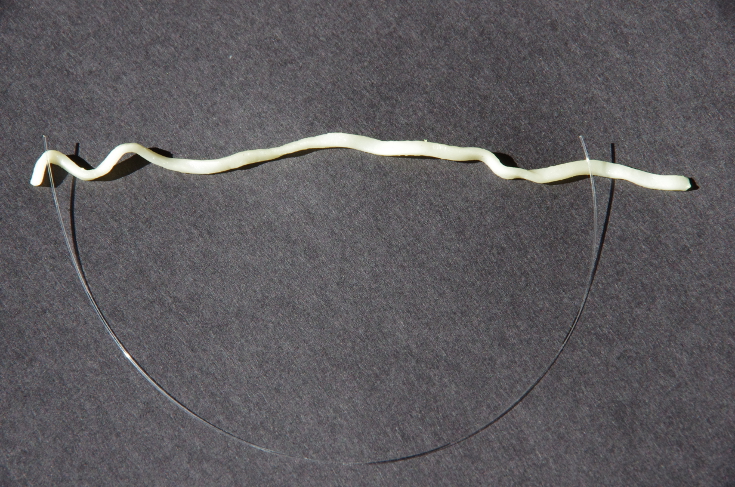
THE “GRAB”: HOW LEADERS AND TIPPETS AFFECT PRESENTATION IN/ON THE WATER
If you can’t get the fly to the fish, then everything else is meaningless. Once the fly is on the water, none of the qualities of the line that aided you with casting will necessarily help you fool the fish. In reality, you choose a line that gives you the best of both worlds, but at this stage in your decision making, you’ve entered the fish’s world where our fly should be most of the time anyway since, as Gary Borger puts it, “We’re not fishing for owls.” The factors important for presentation in or on the water are suppleness/stiffness, diameter, sink rate, color, and visibility.
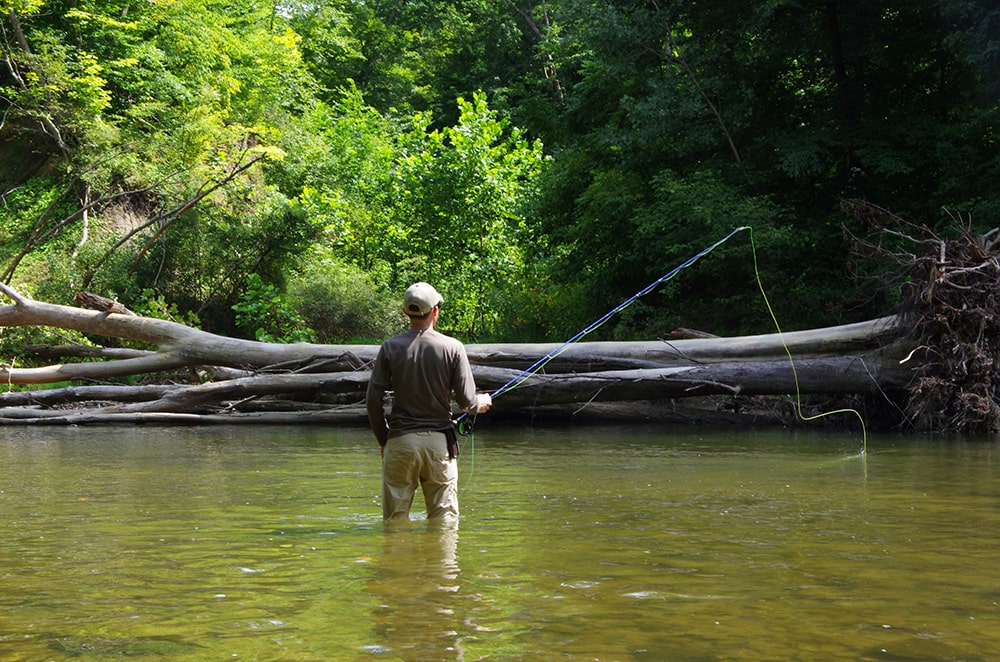
COLOR
Let’s start with color. There are mainly two reasons for choosing different colors of line: 1) because it blends in better with the fish’s environment and 2) so that you can see the line better during the presentation.
Why would you want to see your fly fishing leader or tippet? The main reason is to detect a strike, whether that means seeing the line jump/move or tracking your fly by watching the tippet/leader. Many Euro nymphing anglers use different colored lines in their fly fishing leader construction as indicators/sighters.
It seems somewhat obvious that a tippet/leader that blends in with the fish’s environment is a more desirable than one that does not. The idea goes that you will catch more fish if your line is more inconspicuous, and thus, you should try to match your line to the conditions. Pretty obvious here.
Anglers prefer to have lines that blend in with the color of the water, depth, and general environment. For example, you can use a slightly olive colored line in greenish water or with water that has lots of vegetation. It’s not clear how much subtle changes in line color affect fishing success, but you can experiment with line color depending on your needs for strike detection and blending into the fish’s environment.
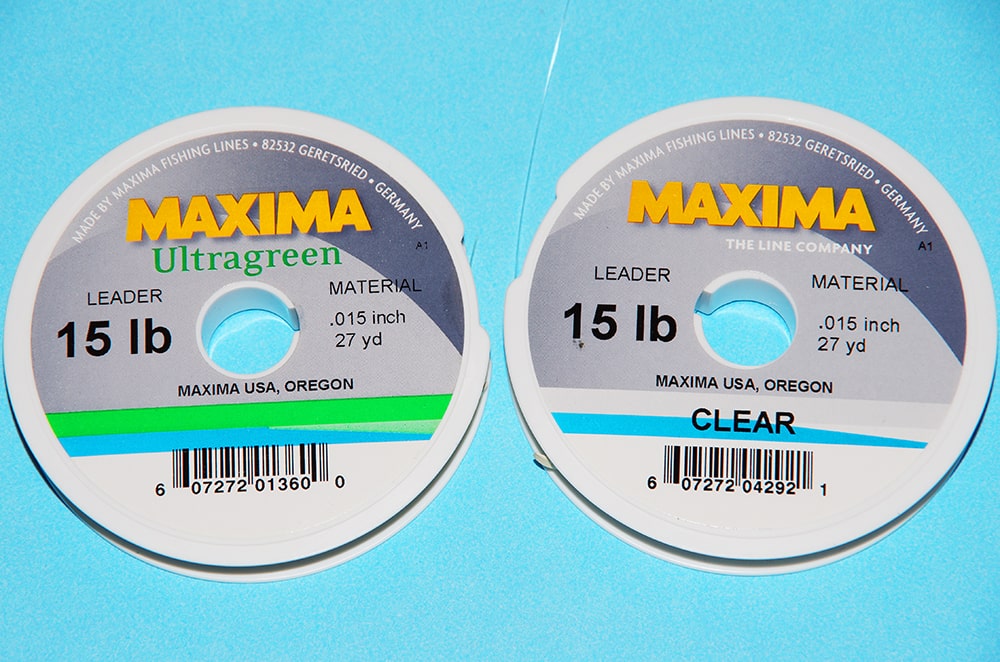
VISIBILITY
Number two, and related to a line being inconspicuous, is line visibility. This explains why most tippets and leaders are clear; they are intended to be as inconspicuous as possible.
A good rule of thumb is to have leaders that meet an acceptable level of invisibility. It is probably impossible to get truly invisible leaders and tippets since fish have excellent eyes underwater, although fish have very different and often less clear eyesight than humans.
Some fly anglers prefer fluorocarbon because it refracts light closer to water than nylon does. I personally have never noticed any difference in fishing success between nylon and fluorocarbon from a visibility standpoint.
The biggest factor that makes leaders and tippets “invisible” to fish is inattentional blindness. Both humans and fish fall prey to this, and it is when our focus is diverted from obvious sights around us onto something else. When fish focus on their prey, the have inattentional blindness to other things around them. Think of a cat that plays with the feather on the string. The string is obviously visible, but the cat engages with the feather anyway.
Line colors and visibility as a deterrent need much more research. The few that have been performed have revealed that bass can see monofilament that is very small in diameter, around .006 (5X), and that they can distinguish between colors quite easily. Bass can also negotiate their environment and catch prey effectively without their eyes. A summary of these studies can be found in O.D. Colin J. Kageyama’s book (159-160).
I tend to agree with Dr. Kageyama’s opinion about anglers going to a smaller diameter to decrease visibility. He states, “It is likely that success is more related to reduced line drag, resulting in greater lure action, sensitivity, and control [not invisibility].”
In the end, it’s probably better to have less visible fly fishing leaders and tippets, but other factors with your presentation and fly are much more important.
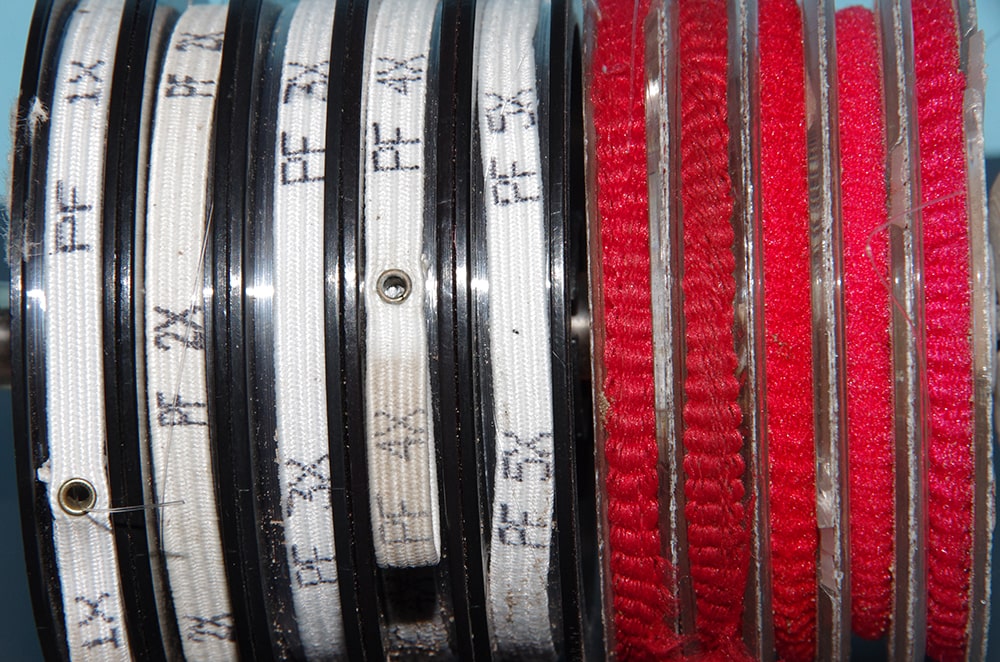
MOST ANGLERS CARRY BOTH NYLON AND FLUOROCARBON TIPPETS.
STIFFNESS/SUPPLENESS AND DIAMETER
Stiffness/suppleness and diameter often do not receive enough emphasis. This is where the balancing act takes place, since these two factors are the most important for casting. For fly action, a supple tippet or leader is almost always better than a stiff one, and the smaller the diameter, the more flexible and supple a line can be.
Supple, small-diameter lines allow a dry fly to remain drag-free on the surface and less susceptible to microcurrents. Nymphs move freely and naturally within stillwater environments and the currents of rivers. Streamer patterns achieve their best movement as well, able to dart back and forth or side to side with greater ease. This is only as far as coaxing the fish to “grab” the fly goes. On the flip side, you may want your fly to move less erratically in cold water situations, so you might intentionally go with stiffer line. These are the options you have when you understand leader/tippet material characteristics.
So, with all things being equal, I want the most supple and smallest diameter tippet and leader I can get for presentation purposes with as much action as possible, but a balance must be met for optimal casting and in-water presentation. If you want more of a gliding movement out of your flies, then a stiffer high diameter line will impede the movement of your fly.
This is where paying more for your fly fishing leaders and tippets is legitimately worth it, particularly for line that is over 0x. Super supple line is very valuable for catching fish.
An easy rule of thumb for matching fly to diameter that has been used for years is as follows; divide your fly by three and round up with a 2 remainder to determine the X value. This is, however, just a quick and easy, but also imperfect, method.
MATCHING DIAMETER TO FLY QUICK RULE EXAMPLES:
Size 14 fly: 14/3 = 4 remainder 2, which is 5x.
Size 12 fly: 12/3 = 4 with no remainder, which is 4x.
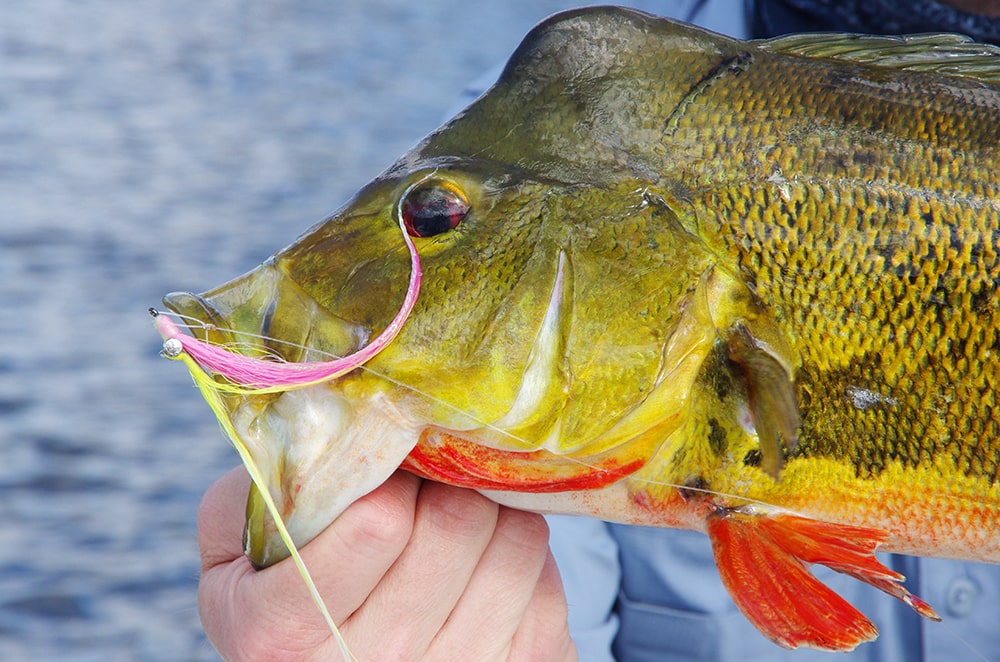
SINK RATE
Diameter goes hand in hand with the final factor, sink rate. Essentially the smaller the diameter, the faster a line will sink because of less water resistance, but note that breaking through the surface film can be difficult with micro diameter tippets (5x – 8x) without weight.
Keep diameter in mind when you want flies to sink fast and easily or when you want flies to hover in the mid-depths, resist sinking, or float. Situations such as these are when you are casting over vegetation, when you want your fly to hover in between strips, or you are fishing a popper, etc.
You must be aware of this when choosing tippet or designing a fly fishing leader, since you may have a leader that sinks weirdly if you have all sorts of different diameters and sink rates involved.
The material of your tippet/leader will also effect sink rate slightly, as fluorocarbon sinks at a slightly faster rate than mono, and because of this, fluoro is often use for sinking flies, while nylon mono is used for hovering flies and floating your flies. Exceptions exist, but this is a good rule of thumb.
Your knot will also affect how fast your fly sinks, and a loop knot will allow your fly to have more action and sink faster. You need to put these all together depending on what you want your fly to do.
Your presentation drives your fly fishing leader and tippet selection. You need to think about the casting demands of your fishing environment and then envision exactly what you want your fly to do once it hits the water. After this, you just need to find the tippet and leader that do all of this best.
At this point you haven’t thought about the breaking point of your line yet because you haven’t even set the hook yet. Neglect the “grab” and the “nab” never happens.
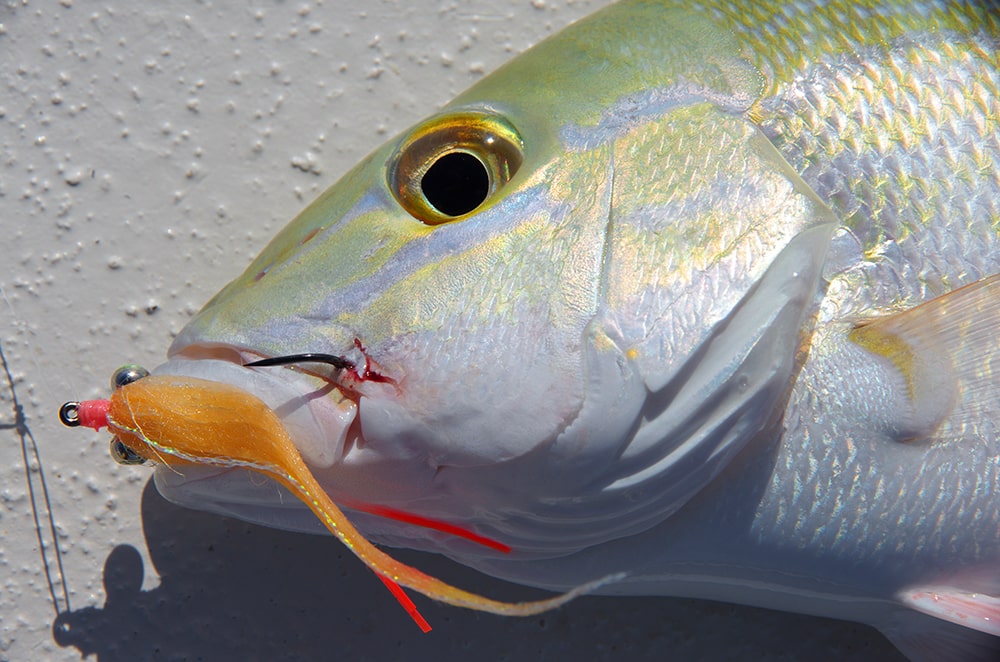
THE “NAB” WITH YOUR FLY FISHING LEADERS AND TIPPETS
Once an angler actually fools the fish into taking the fly, the hookset and landing of the fish becomes the focus. I refer to this process as the “nab.” Any aspect of the line (leader or tippet) that was used to present the fly or fool the fish can be treated separately from the aspects you need to drive the hook in and then land the fish. The supple, small-diameter fly fishing tippet you used to make the fly look alive may now be your biggest obstacle to landing the fish. As fly anglers, we always try to get the best of both worlds, but just from the standpoint of setting the hook, what would the ideal line look like?
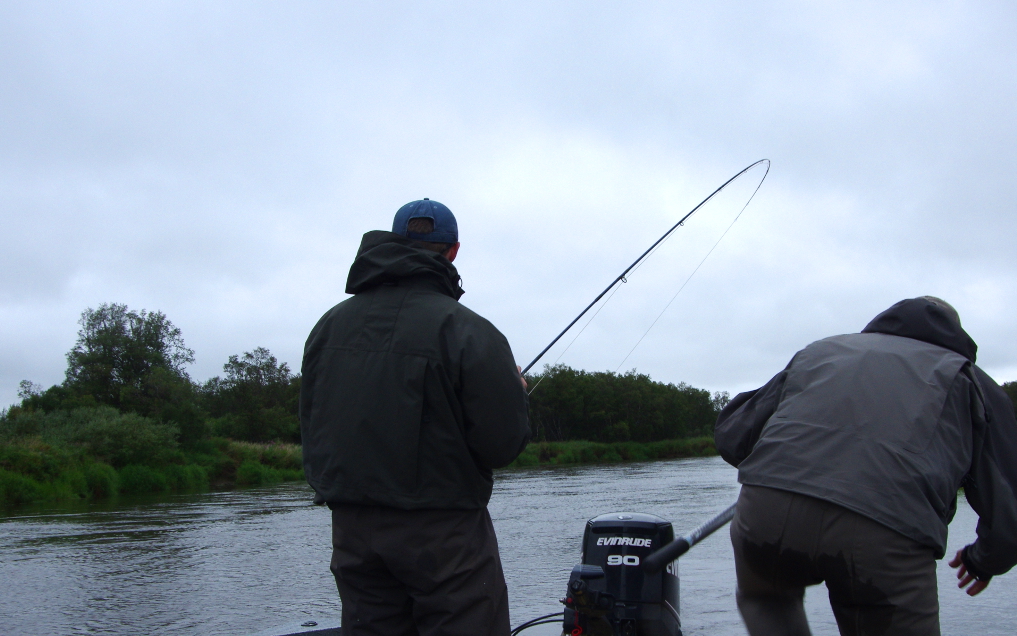
THE “NAB”: SETTING THE HOOK
HOOKSET AND LINE SENSITIVITY
Sensitivity and control is important before we set the hook, and certain leaders and tippets help the fly angler. However, fly fishing, unlike general tackle, does not put as much emphasis in the sensitivity and control of the leader, since the fly line is usually the first and direct connection between the angler and what the fish is doing. The fly line, along with the rod, acts as the primary means to control the fly and feel the strike during presentation.
With this in mind, it seems as though our fly fishing tippet and leader selection is neutralized somewhat by our fly lines. Although higher memory lines must be stretched for them to have a more direct connection to the fly. Line management to provide a direct connection to our flies is the most important aspect of sensitivity and control.
HOOKSET TECHNIQUE
The most important part of setting the hook is technique, not your fly fishing leaders and tippets. Once you’ve got the hookset down, more or less, you can fine tune the aspects of your gear to make your technique more effective.
For example, when you want to lessen the force or delay its effect of a hookset, a soft rod tip, extra fine wire hook for penetration, a loop of line for shock absorption, or even a spring in the reel (see Einarsson’s Invictus) can aid in properly sinking the hook into the fish without breaking the tippet.
When you want to set the hook with more force, a strip strike ranging from just an even pull of the line to a Mike-Tyson-like, thunderous and explosive yank will do the job. Technique aside, your fly fishing tippet and leader need to have certain qualities to maximize, or minimize, the hookset.
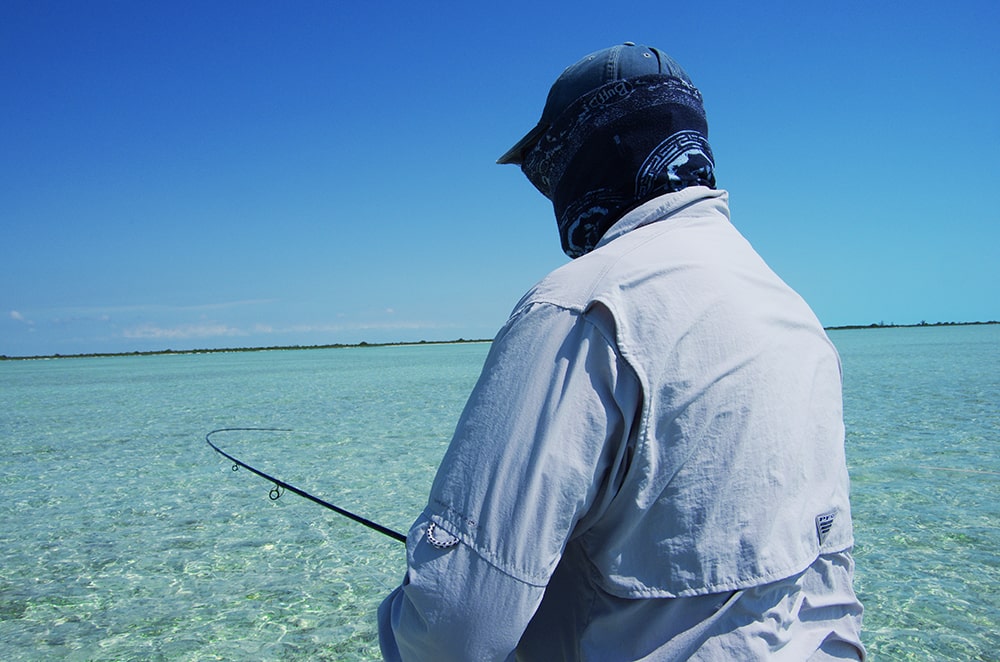
HOOKSET: FLY FISHING LEADERS AND TIPPETS
When we’ve maximized line sensitivity and mastered hookset technique, we can then consider the leader and tippet qualities that will help us accomplish our goal of driving the hook home without breaking our line.
Setting the hook then falls between 1) wanting to lessen the force of the hookset because of a delicate fly fishing tippet and small flies and 2) needing to get as much power behind the hookset as possible to penetrate bony mouths and overcome powerful jaw pressure. Three properties of your line will aid in setting the hook properly: stretch, tensile strength (breaking strength), and knot strength.
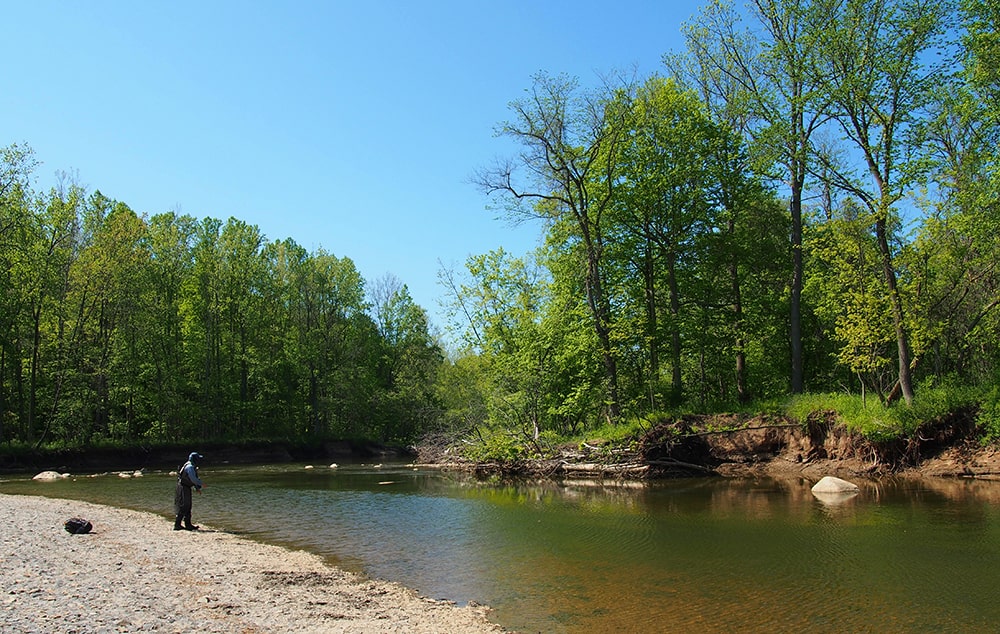
LINE STRETCH
Stretch in your fly fishing leaders or tippets determine how much power you can generate on the hookset. A low stretch line (in fly lines, leaders, and tippets) is what you want for maximum hookset power, while a high stretch line is what you might want for softer hooksets.
Once again, diameter affects how stretchable your line is; more or less, the higher the diameter your line is the less stretch your line has in comparison to a given force on the line.
The unique properties of the material and formulation affect stretch greatly as well. Out of the three main line types (braid, fluoro, and nylon), the least stretchable is braid, followed by fluoro, and lastly nylon. There is some debate on the last two, however, since elasticity and plasticity play a role in choosing lines. In addition to this fact, there also exists variance within these respective lines, for example, not all nylon and fluoro monofilaments stretch the same.
Stretch is very much related to suppleness, i.e., the more supple the line is, the more likely it is to have stretch. Therefore, think about what you are trying to do on the hookset and choose your line accordingly.
SOFT HOOKSET: high-stretch, thin-diameter nylon
STRONG HOOKSET: low-stretch, large-diameter flourocarbon or braid
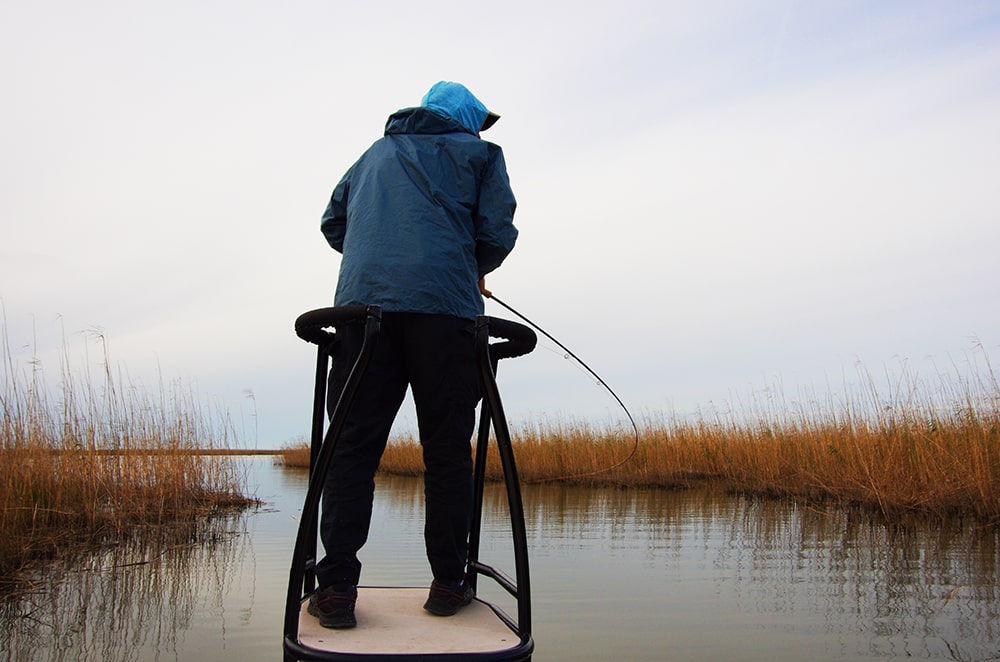
BREAKING STRENGTH
Both breaking strength and knot strength are extremely easy to generalize: you want the strongest line with the best knot strength around. However, with this type of line (low stretch and high breaking threshold) you may bend hooks or pull the fly out of the fish’s mouth because of so much pressure. Despite this, we almost always want the highest breaking strength possible unless “sport” is an issue, or there is a concern for breaking the fly line.
Notice this is the first time we have considered line breaking strength. Once again, we must balance out all of our needs to arrive at the most appropriate line choice. The “grab” takes priority, so we must make do with what features our line provides us for the hookset in order to fool the fish. Hookset technique can overcome some of the limitations of our line, optimized for the “grab.” In a lot of cases, we can get the best of both worlds though.
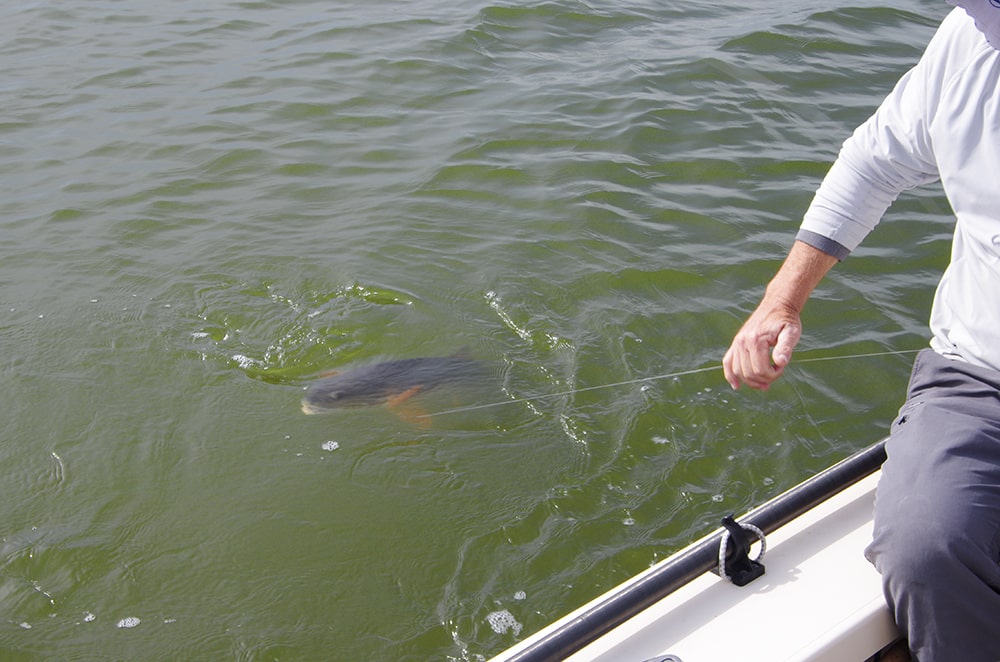
THE “NAB”: LANDING FISH
A good hookset is the best way guarantee that you’ll land a fish, particularly in open water. After you’ve hooked the fish, you should land the fish as quickly as possible. To lessen strain on the fish, we must exert as much pressure on the fish as our bodies and equipment will allow. Except in those situations where we risk pulling the fly out (in this case stretch lines come into play), we need the ability to put real pressure on the fish. Three main factors really determine our success in playing a fish when considering our fly fishing leaders and tippet: abrasion resistance, breaking strength, and knot strength, although stretch can play a role at times as well.
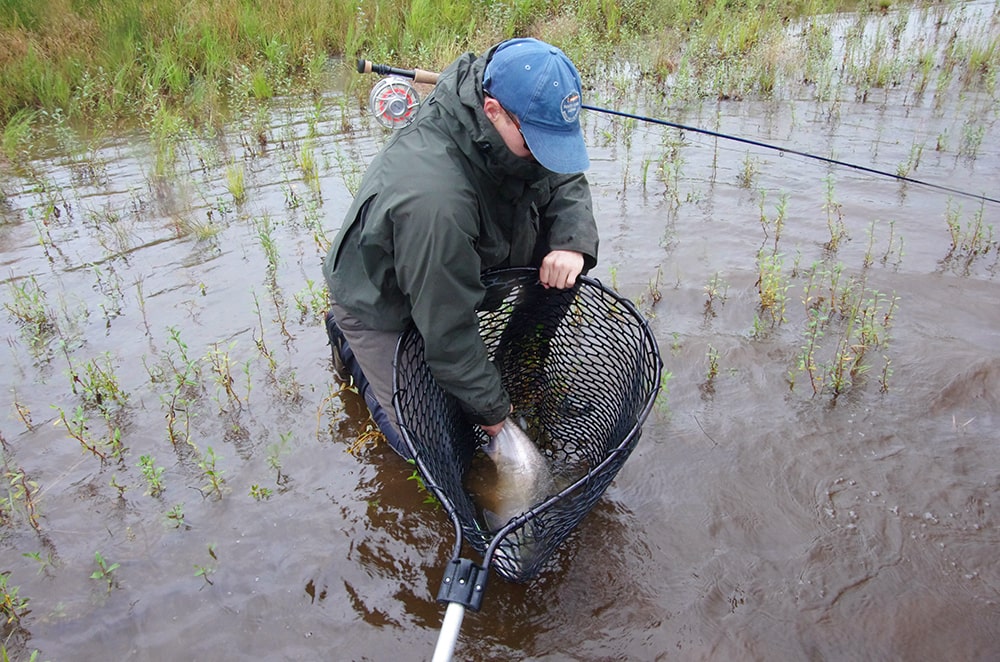
ABRASION RESISTANCE
Abrasion resistance can actually come into play on the hookset since toothy critters can bite right through our lines. For example, small to medium sized barracuda can become a real nuisance on the flats, since they can cut through 20 lb. fluorocarbon as if it were not even there. For this reason, straight wire and knottable nylon coated wires are critical with certain species such as bluefish, barracuda, and northern pike. This introduces the first way of increasing the abrasion resistance of your leaders/tippets, choose a material that is nearly impervious to toothy critters.
The other way is to increase the diameter of your “standard” fly fishing tippet and leader. Many musky anglers use straight 100 lb. fluorocarbon for their entire leader, while others use heavy nylon monofilament. Thick leaders are also mandatory for tarpon, snook, trevally, etc.
In some instances, the long powerful fight plays a part in choosing this heavier leader, but the abrasive mouths and gill plates of these fish are more of the reason for these thicker diameter lines, particularly when pursuing the smaller versions of these fish, since you don’t need a high pound test to land them normally, but you do need the abrasion resistance.
Abrasion resistance is not only important for the fish’s mouth but for coral, trees, sharp rocks, etc.
You can also boost your abrasion resistance by choosing fluorocarbon or a particularly abrasion resistant nylon, which is a part of the process of making and extruding the nylon.
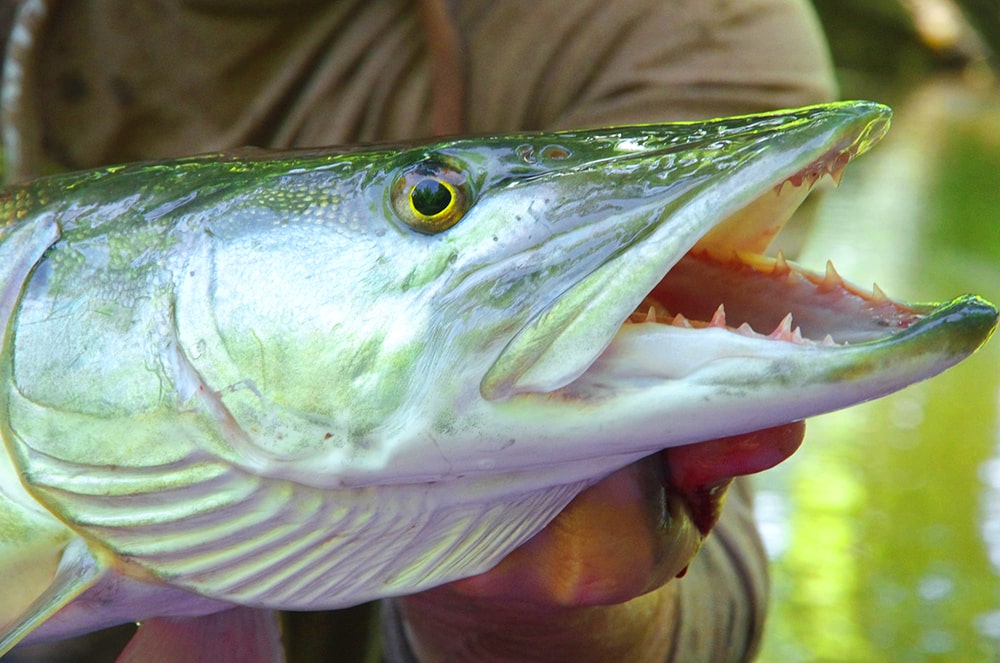
FISH LIKE MUSKY HAVE ABRASIVE MOUTHS THAT WILL CUT YOUR TIPPET AND KNUCKLES.
BREAKING STRENGTH AND KNOT STRENGTH
Hopefully by now, it has become apparent that choosing fly fishing tippet and leaders should require some thought and experimenting to fine tune. For most species, there are a host of flies that will work, but match these flies with the right fly fishing tippet and leader (and knot), and it can make all the difference in the world.
There remains the last factor(s) for landing fish: breaking strength and knot strength. Once again, this is simple: the higher the breaking strength and knot strength, the better. I personally do not believe in using small pound test to be more “sporting” and have little desire to go after line class records. To those who do, this will not apply.
Everyone would acknowledge that landing a fish as fast as possible is better for all involved. The shorter the fight, the fewer the variables for losing a fish during the fight. Barracuda, sharks, brush piles, acrobatic jumps, etc., all pose real threats while fighting a fish. In addition, a shorter fight is way better for the fish’s survival. For these reasons, I will buy expensive leaders and tippets that have the best features of presentation but allow me to go as high as possible on breaking strength.
Thus, no good angler or guide should make a decision on what fly fishing tippet or leader to use based off of some predetermined number like 12 lb. test for bonefish. If the leader has the proper characteristics for great presentation but happens to be 18 lb. test, then we should take advantage of these technological advances.
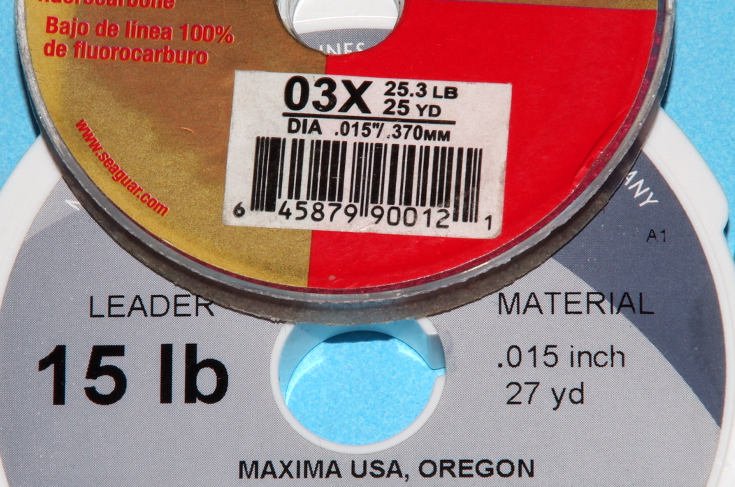
THESE TIPPETS HAVE THE SAME DIAMETER BUT DIFFER BY TEN POUNDS IN BREAKING STRENGTH.
CONCLUSION: FLY FISHING LEADERS AND TIPPETS
The best anglers in the world understand fly fishing leaders and tippets, and how they affect your fishing. They are a critical part of your fishing and arguably make a larger impact on your success than your fly rod, fly reel, and possibly even your fly line. Below is a summary of what we’ve gone over. If you master these aspects of your tippet and leaders, you are guaranteed to catch way more fish.
FLY FISHING LEADERS AND TIPPETS QUICK GUIDE
1) Buy or build a leader
- Design your own leader or purchase one from a manufacturer.
GRAB
2) Casting
- Leader length, diameter, suppleness/stiffness (temperature affects this)
3) Presentation (in/on water)
- Leader length, diameter, suppleness/stiffness, sink rate, color, and visibility
NAB
4) Hookset
- Line sensitivity, stretch, breaking strength, and knot strength
5) Landing fish
- Abrasion resistance (material, diameter), breaking strength, and knot strength

